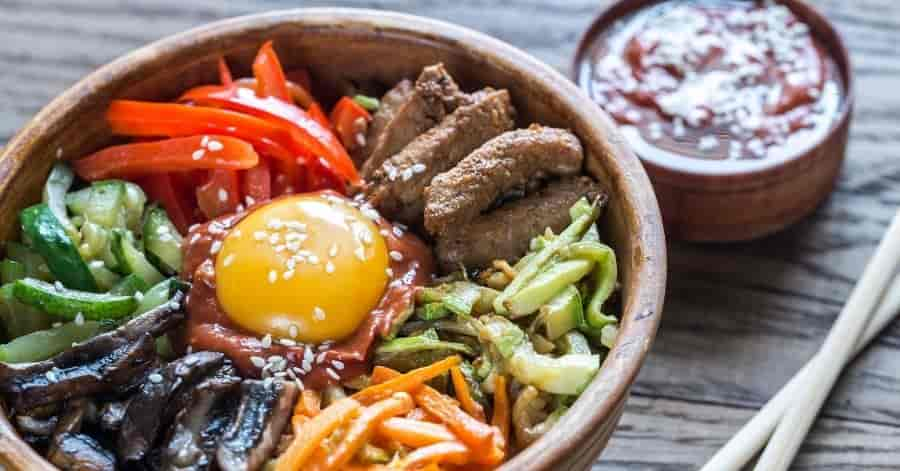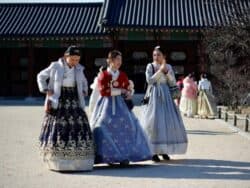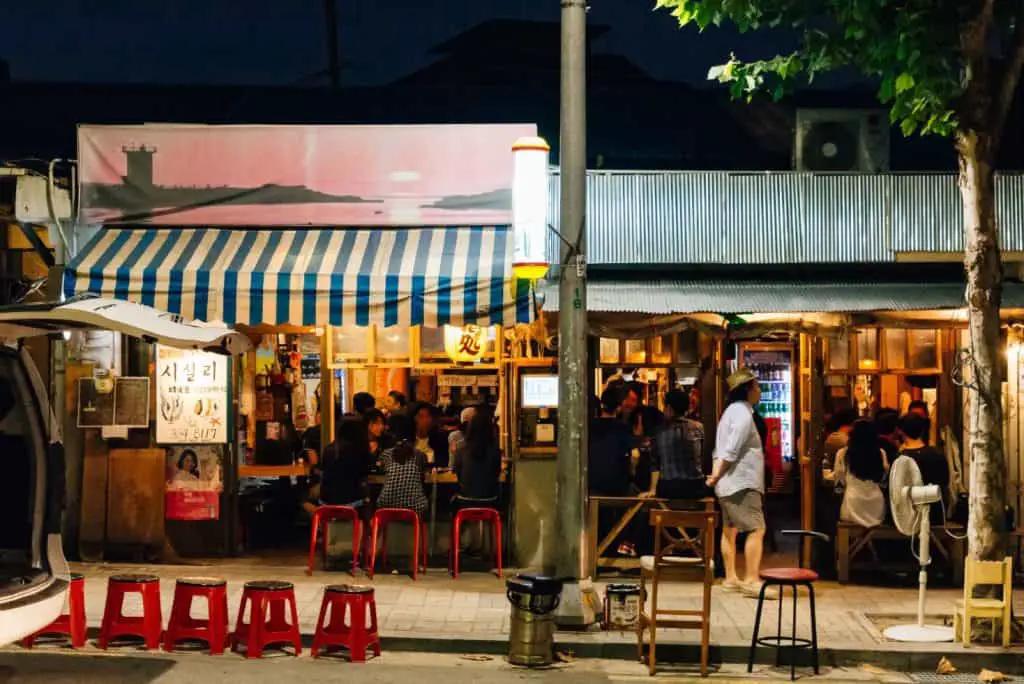For all the foodies out there, we are here to take you on a delightful food tour. Traditional Korean food is healthy, rich, flavorful, and easily accessible. Let’s discuss how the Korean traditional recipes are made, what ingredients are used in the preparation. Furthermore, how it tastes and the famous restaurants where you can try that respective dish in Seoul. If you are in Seoul, we also recommend checking out the best traditional Korean food Full-Course cooking class.
Read also:
- Best Korean Street Food
- How to order food delivery in Korea
- Gwangjang Market: Best Korean Street Foods
- Official Halal Certified Restaurant
The best traditional Korean food is here
Korean BBQ
Korean BBQ is considered the most popular traditional Korean food. It is locally referred to as gogi-gui. This method follows Korean cuisine in which the meat, beef, or chicken is grilled on the gas stove or the charcoal grills that are inlaid into the dining table. This is up to the customer’s choice whether they want them to be marinated or not. Korean BBQ is different from other BBQs as a different breed is used here. Besides, Korean BBQ comes with the side dish of kimchi which is fermented cabbage loaded with garlic and spices. It tastes tangy, salty, and a bit sweet. There are various types of kimchi but with Korean BBQ I prefer the spicy cabbage one that complements the Korean BBQ’s taste.
We have seen in the restaurants having the stunning grills fixed in the center of the tables and the ventilation setup. But we can also have the same taste prepared at home. Furthermore, a Korean BBQ Party is the perfect meal to invite your friends and have fun. Let’s have a look at how we can prepare the Korean BBQ in your place.
Ingredients
The ingredients to be collected are meat, some spices, a grill and some people to have the meal.
In traditional Korean BBQ, Galbi ribs and Bulgogi are used. Bulgogi refers to the thin slices of beef or pork, which are deeply marinated with a soy-based sauce. But if you are getting short of bulgogi then you can simply use boneless chicken thighs, this will also work. Now cut the beef into one-fourth inches.
The other ingredients are the sesame oil and seeds, fish sauce, sugar, garlic, ginger, white vinegar, fermented Korean chili paste known as gochujang, soya sauce, and some scallions. You will also need some veggies like spinach, cucumbers, kimchi, and pineapple.
Instructions
1. In this step, you need a hot and clean grill. Charcoal grill to be preferred. In this, you have to wait till the charcoal turns white and if you are having any digital thermometer then you can measure the temperature going to 250- 300 Fahrenheit.
2. For the amazing spice blend, mix up the onion powder, salt, black pepper, smoked paprika, sugar, garlic powder, and some cayenne. Blend them in a bowl. Once the spice blend is ready, it is used to coat the outer layer of the meat which will result in the crispiness of the exterior layer.
3. The third step includes the preparation of the meat.
If you want the chicken to stay moist, then you should bring it at home in advance. It will be kept moist, and will not dry out. You have to prepare a mixture of salt, sugar, and water and leave your meat overnight in it to rest. This will lock the moisture in the meat.
Another good idea is to marinade the ribs at night before grilling. Let the meat rest from 15 minutes to 24 hours in the refrigerator, do not disturb in between. Before cooking you need to maintain it according to the room temperature.
4. To prepare the cukes, slice the Persian cucumbers. Mix the garlic cloves, sliced scallion, fish sauce, and gochujang into a paste. Cut the cucumber in this paste. Now, wash the spinach and sprinkle it with sesame seeds. At last, it will only take 40 minutes for the cooking
5. The last step includes the grilling
On a dry chicken, coat a thick layer of the seasoning mix on both sides. Pour the marinated chicken into the Korean sauce. Then, separate each piece of the meat at a distance of half an inch. This will maintain the temperature and steam it. Flip it when required at a temperature of 160 Fahrenheit. Once the edges start to curl up, quickly flip it up. And your traditional Korean BBQ is ready to serve.
The best Korean BBQ restaurants in Seoul
We picked three restaurants in Seoul here. For the full list of the best Korean BBQ restaurants in Seoul and their popular menu, check THIS POST.
- Wangbijib Myeongdong
Address: 26 Myeongdong 8ga-gil Junggu Seoul
Open hours: 11:30 – 23:00
Phone: +82-2-3789-1945
- Palsaik Samgyupsal
Address: 18 Backbeom-ro Mapo-gu Seoul
Open hours: 11:00 – 23:00
Phone: +82-2-719-4848
- Mapo Sutbul Galbi
Address: 232 Dosandae-ro Gangnam-gu Seoul
Open hours: 11:00 – 06:00
Phone: +82-2-516-1522
Korean Beef Bulgogi
Another great traditional Korean food is the Korean beef bulgogi. It tastes a bit sweet, juicy, with a great topping of garlic, ginger, soy sauce, which makes it a little tender.
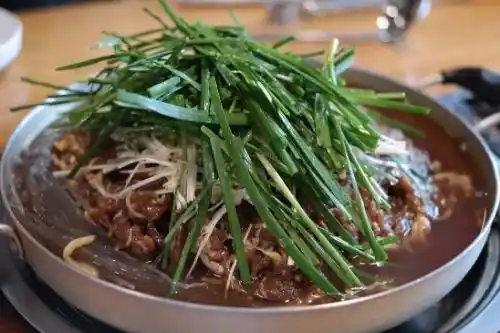
Ingredients
Boneless rib, light brown sugar, sesame oil, cloves, garlic, soy sauce, vegetable oil, onions, toasted sesame seeds, gochujang, and small pear grated.
Instructions
- Prepare the beef and slice it across the grain approximately one-fourth inch thick
- Also prepare the paste by combining soy sauce, ginger, garlic, brown sugar, pear, and gochujang. Mix well and pour all the slices into it. Let the marinated slices rest for 2 hours or overnight in a ziplock bag
- Take 1 tablespoon vegetable oil and heat it on the grill pan. Add all the slices one by one in the pan in a single layer and cook by flipping when required. Repeat the process until it becomes crispy.
- Now your Korean Beef Bulgogi is ready to serve.
The famous restaurants where you can try this dish in Seoul are
- Sandeomi Bulgogi 산더미 불고기
- Address: 47 Eoulmadang-ro Mapo-gu Seoul
- Open hours: 13:00 – 24:00
- Phone: +82-2-323-8226
- Hwangso Gojip (Gochujang Bulgogi) 황소고집
- Address: 75-1 Cheonggyecheon-ro Jongno-gu Seoul
- Open hours: 11:00 – 21:00
- Phone: +82-2-722-5747
- Yukjeon Hoekwan | Michelin Guide 2020 역전회관
- Address: 47 Tojeong-ro Mapo-gu Seoul
- Open hours: 11:00 – 22:00 | Break time 15:00 – 17:00
- Phone: +82-2-703-0019
Bibimbap
Bibimbap can be familiar with you as a representative of traditional Korean food. It is rice mixed with vegetables and meat (option) in the bowl or hot pot and tastes a little bit spicy with Gojuchang, chili paste. However, you can put the amount you want or soy sauce instead. I’m sure all the food lovers would love to try it.
Ingredients
Short grain rice, soybean sprouts, spinach, carrot, red pepper, zucchini, cucumber, chopped onions, beef slices, fern brake, gosari, bellflower roots, eggs, kosher salt, toasted sesame oil, vegetable oil, garlic, sesame seeds, soy sauce, honey and gochujang.
Instructions
- Heat the pan, add a few drops of cooking oil, and fry the carrot.
- Saute the cucumber with garlic and sesame oil.
- Saute the red pepper and sprinkle the salt.
- Then Saute the zucchini with garlic, chopped onion, sesame oil.
- Saute the bellflower with garlic and sesame oil.
- Mix all the above items very well in a hot pan and serve well with egg yolk.
- Sprinkle the sesame seeds.
- Serve hot
The best restaurants for bibimbap in Seoul are
- Gogung Myeongdong Branch 고궁 명동점
- Address: 27 Myeongdong 8ga-gil Jung-gu Seoul
- Open hours: 10:30 – 22:30
- Phone: 0507-1380-3211
- Mokmyeoksanbang | Michelin Guide 2017, 2018, 2019 목멱산방
- Address: 71 Togye-ro 20-gil Jung-gu Seoul
- Open hours: 11:00 – 21:00 | Break time 15:00 – 16:30
- Phone: +82-2-318-4790
- Web: https://mmmroom.co.kr/
- Gonbap 곤밥
- Address: 105 Tojeong-ro Mapo-gu Seoul
- Open hours: 11:30 – 21:30 | Break time 15:00 – 17:00
- Phone: +82-2-336-5157
Chicken & Beer (Chi-mac)
Might you have heard that Korean fried chicken is another level. So, it’s time to try and enjoy it! It is a lethal combination of fried chicken and beer. Fried chicken is not traditional Korean Food but the fried chicken with a sweet-spicy sauce called Yangnyeom-chicken is made in Korea. It tastes so amazing!
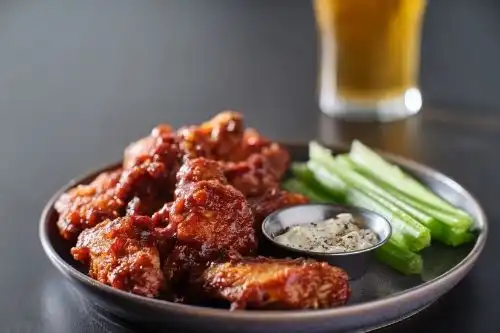
Ingredients
Chicken, salt, black pepper, ginger, peanuts, soy sauce, rice syrup, brown sugar, ketchup, gochujang, seasame
Recipe
- Prepare the sauce with all the ingredients according to your taste.
- Then, use all the ingredients that are used above to make the sauce.
- Deep fry the chicken and serve with hot spicy sauces.
- Along with the chicken, you can prepare the beer at home but as it takes time you can simply go out and purchase your favorite one.
- Now you can enjoy the lethal combo of the fried chicken and beer.
HERE, you can find the best Korean fried chicken restaurants in Seoul.
Jjajangmyeon & Jjamppong
Jjajangmyeon and Jjamppong are Korean-style Chinese food. You might think it’s a bit weird when you have it first due to Jjajangmyeon’s black sauce. However, you’ll love it if you taste it. The thick sauce topped is sweet and savory made of Chunjang (sweet bean paste), diced pork, and various vegetables. While Jjamppong is a spicy noodle soup with various vegetables and seafood. Also, these menus are some of the most common delivery foods in Korea. In this post, you can check how to order food delivery in Korea using the app. Try it!
Ingredients (for 4 servings)
- 3 tablespoons Jjajangmyeon sauce (Chunjang)
- 4 portions of noodle (Jungwhamyeon or Udonmyeon)
- 3 medium-sized onions – 250g of Shrimps
- 2 Potatoes – 100g Green onion – 600ml water
- 2 tablespoons cooking oil
- 2 tablespoons sugar
- 2 tablespoons oyster sauce
- 1 tablespoon potato starch
- 1 teaspoon chicken stock
Instructions
- Boil the noodles.
- Cut and slice the vegetables
- Slice down the pork, mussels, shrimps.
- Heat the pan and prepare a paste of oil, ginger, soy sauce, scallion, and gochugaru.
- Add pork and fry
- Mix the veggies and salt according to the taste.
- Add the chicken stock
- Add the seafood
- And add the noodles to it and serve hot
The best restaurants to try Jjajangmyeon in Seoul are
- Hyodonggak Main Branch 효동각 본점
- Address: 24 Yeondaedongmun-gil Mapo-gu Seoul
- Open hours: 12:00 – 15:00 | Mon. Sun. Closed
- Gonbap 곤밥
- Address: 105 Tojeong-ro Mapo-gu Seoul
- Open hours: 11:30 – 21:30 | Break time 15:00 – 17:00
- Phone: +82-2-336-5157
- Gonghwachun 공화춘
- Address: 42 chinatown-ro Junggu Incheon
- Open hours: 10:00 – 21:30
- Phone: +82-032-765-0571
Samgyetang
This dish is healthy traditional Korean food consisting of flavored chicken with the herb. When you order it in the restaurants, a tender young whole chicken soup in the hot pot will be served. There are various stuff like ginseng, jujubes, sweet rice, and whole garlic cloves inside a chicken that create a complex yet harmonious flavor. Even if Samgyetang is kinda warm food, this is a classic summertime dish since we believe that revitalizes the body and soul.
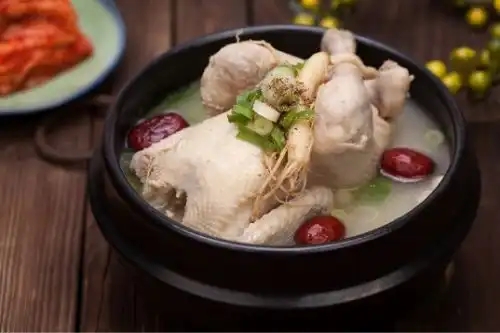
Ingredients
Chicken, sweet rice, Korean ginseng, garlic cloves, dried jujube, Ginko nuts, frozen chestnuts, onion slices, salt, black pepper.
Recipe
- Wash the chicken and fill the chicken cavity by stuffing sweet rice, garlic cloves, ginseng, gingko nuts, chestnuts, and jujube. Tie the crossed legs which prevent the filling to pop out.
- After that, add water in a large pot, pour the chicken and heat.
- After proper heating garnishes with onions and serve.
The best restaurants in Seoul where you can try Samgyetang are
- Tosokchon 토속촌
- Address: 5 Jahamun-ro 5-gil Jongno-gu Seoul
- Open hours: 10:00 – 22:00
- Phone: +82-2-737-7444
- Gangwonjeong 강원정
- Address: 13-10 Wonhyo-ro 89-gil Yongsan-gu Seoul
- Open hours: 11:30 – 20:30 | Break time 14:30 – 17:30 | Sun. Closed
- Phone: +82-2-719-9978
- Korea Samgyetang | Michelin Guide 2020 고려삼계탕
- Address: 1 Seosomun-ro 11-gil Jung-gu Seoul
- Open hours: 10:30 – 21:30
- Phone: +82-2-752-9376
Jeon & Makgeolli
Jeon is one of the beloved traditional Korean food by locals and visitors from all around the world. This is made by seasoning sliced or chopped fish, vegetables, meat, seafood, etc., Then coating them with wheat flour and egg wash before frying them in oil. Gamjajeon(potato pancake), Kimchi Jeon, Haemul Pajeon(seafood pancake), Nokdu-bbindaettek (mung bean pancakes) are the most popular Jeon menu in Korea.
Furthermore, you should try to have them with Makgeolli that is Korean traditional rice wine. It tastes a little bit sweet, salty, and bitter which is a perfect combination with Jeon. Somehow Korean people want to have this food, Jeon & Makgeolli on rainy days 🙂 So, probably the makgeolli bars in Korea could be crowded on those days.
Ingredients
Mung beans, sweet rice, soy sauce, vinegar, pork, kimchi, fern brake, mung bean sprouts, egg, chopped green onions, garlic cloves, salt, black pepper, sesame oil, silgochu and vegetable oil.
Instructions
- Mix the mung beans with sweet rice in a bowl, drain and leave overnight.
- Mix the vinegar and soy sauce to make the topping.
- Take the mixture of mung beans and rice with a bowl of a food processor and grind.
- Mix gosari, onion, kimchi, garlic, mung bean sprouts, egg, pork, salt, black pepper, and sesame oil.
- Heat the pan, add vegetable oil and stir well.
- Add the batter and spread with the spoon in the shape of a pancake.
- Flip it when required and serve hot.
For the best Makgeolli place with top-notch foods, check THIS POST.
Gamjatang
Gamjatang is the thick soup of pork and potato. The taste is very flavorful, spicy, and slightly sweet with onion, green cabbage leaves, and perilla leaves. A spicy Korean dish with a deep and robust flavor.
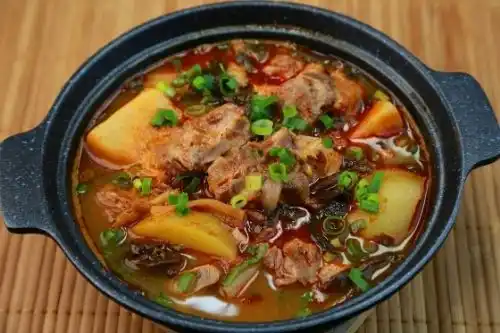
Ingredients
Pork, sliced ginger, doenjang, shiitake mushrooms, sliced onion, red pepper, Napa cabbage, potatoes, soybean sprouts, green onions, perilla leaves, garlic cloves, gochugaru (dried red pepper flakes), gochujang (red pepper paste), fish sauce, deulkkae-Garu, black pepper, and water.
Recipe
1. Take the pork bones and let them rest in the water for 30 mins.
2. Boil the water and add cabbage.
3. Rinse the cabbage with cold water and tear the leaves accordingly.
4. Boil the bones and cover. The water will become dark and foam will the at the surface.
5. Strain the bones.
6. Make the seasoning paste by mixing garlic, hot pepper, fish sauce, black pepper, perilla seeds powder and water.
7. Mix well
8. Prepare the veggies by slicing and pour them in the paste. Also, add the bones to it.
9. Add perilla leaves and serve with rice.
The restaurants to try this dish in Seoul are
- Halmaejip | Michelin Guide 2020 할매집
- Address: 1-5 Sajik-ro 12-gil Jongno-gu Seoul
- Open hours: 12:00 – 21:30
- Phone: +82-2-735-2608
- Somunnan Seongsu Gamjatang 소문난성수감자탕
- Address: 45 Yeonmujang-gil Seongdong-gu Seoul
- Open hours: 00:00 – 24:00
- Phone: +82-2-465-6580
- Jangsu Gamjatang 장수감자탕
- Address: 9-10 Dobong-ro 3-gil Seongbuk-gu Seoul
- Open hours: 11:00 – 23:00
- Phone: +82-2-980-1003
Naengmyeon
Another delicious traditional Korean food is the Naengmyeon. Bukwheat noodles served in chilled soup made of dongchimi (radish kimchi) and beef broth. It holds a hint of sweet, tangy flavor and goes well with vinegar and mustard.
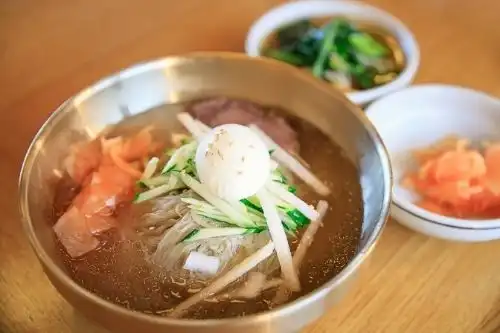
Ingredients
Naengmyeon noodles, mustard oil, cucumber slices, Korean pear, kosher salt, sugar, apple cider vinegar, boiled egg, sesame seeds, and ice cubes.
Recipe
1. Take the concentrated broth and mix it with water.
2. Refrigerate for 4-5 hrs.
3. Take cucumber slices and mix them with kosher salt, sugar, vinegar.
4. Prepare the sugar syrup by adding water and sugar.
5. Take the sliced pear and put them in the sugar syrup till they change the color.
6. Grate the Korean pear and squeeze all the juice out of it.
7. Take the bowl of the broth and squeeze the cucumber brine in it. Also, add the pear juice.
8. Stir well and again refrigerate.
9. Prepare the noodles and pour them in icy broth.
10. Add mustard oil and sprinkle the sesame seeds.
11. Add half an egg on the top and serve cold.
The best Nangmyeon restaurants in Seoul are
- Naksan Naengmyeon 낙산냉면
- Address: 8 Jibong-ro 5-gil Jongno-gu Seoul
- Open hours: 11:00 – 21:30
- Phone: +82-2-743-7285
- Eulji Myeonok 을지면옥
- Address: 2-1 Chungmu-ro 14-gil Jung-gu Seoul
- Open hours: 11:00 – 21:00 | Break time 15:30 – 17:00
- Phone: +82-2-2266-7052
- Bongpiyang Bangi Branch | Michelin Guide 2020 봉피양
- Address: 205-8 Bangi-dong Songpa-gu Seoul
- Open hours: 11:30 – 22:00
- Phone: +82-2-415-5527
Dakgalbi
Dakgalbi is one of the favorite foods from visitors. It’s a spicy chicken marinated in a gochujang (red chili paste) sauce and cooked with various vegetables like onion, cabbages, spring onion, rice cake. This is for the foodies who love spicy chicken. But, if it’s too spicy for you, even you can add mozzarella cheese on the top that makes it milder.
Ingredients
Deboned drumsticks or chicken breast, soy sauce, minced garlic, ginger, gochujang (spicy red pepper paste), gochugaru (dried spicy red pepper flakes), mirin, black pepper, sliced cabbage, sliced onion, garaeddeok (rice cakes), sweet potato sliced, carrot, green chili peppers, perilla leaves.
Recipe
1. Slice the chicken, add soy sauce and black pepper.
2. Make the sauce by mixing ginger, garlic, hot pepper, soy sauce, cooking wine, and hot pepper paste.
3. Then heat the pan and place the cabbage at the bottom and add rice cake, onion, carrot, green chili peppers, and sweet potato.
4. Also, add perilla leaves.
5. After the leaves are shrunk, add the marinated chicken and put the topping on it.
6. Cook for 2-3 minutes and serve hot.
The best Korean restaurants to try it out in Seoul are
- Sinmigyeong Hongik Univ. Dakgalbi 신미경홍대닭갈비
- Address: 32 Hongik-ro 3-gil Mapo-gu Seoul
- Open hours: 11:00 – 23:00
- Phone: 0507-1325-5222
- Todak Todak 토닭토닭
- Address: 38 baekjegobun-ro 45-gil Songpa-gu Seoul
- Open hours: 11:00 – 20:50
- Phone: 0507-1438-0208
- Ogeunnae Dakgalbi 오근내닭갈비
- Address: 15 Ichon-ro 29-gil Yongsan-gu Seoul
- Open hours: 11:30 – 22:30
- Phone: +82-2-797-0131
Budae Jjigae
Budae-jjigae has a relatively short history by being created with foods from the US during the Korean War. It is a fusion stew made with ham, sausage, kimchi, tofu, vegetables, and noodle (ramyeon). They are mixed into a broth and boiled. This spicy Korean food has an addictive taste with spam that you can’t imagine before you have.
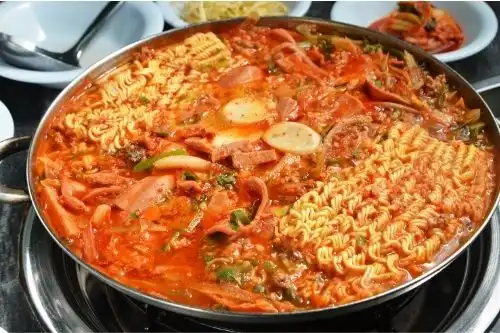
Ingredients
Anchovies, shiitake mushrooms, kelp dried, water, kosher salt, hot pepper paste, garlic cloves, hot pepper flakes, soy sauce, sugar, pork belly or shoulder, sliced cabbage, sweet potato starch noodles, kimchi, green onions, spam, tofu, polish sausage, radish sprouts, rice cakes, and cheese.
Recipe
1. Add water, mushrooms, anchovies, cook for half an hour, and add pork. Cook again for 10 mins.
2. Remove the pot from heat and take out the mushrooms for slicing.
3. Strain the ingredients from the pot.
4. Then prepare the paste by adding hot pepper paste, garlic, soy sauce, water, hot pepper flakes and mix well.
5. Spread the cabbage, onion, pork, mushrooms and green onions at the bottom of the pot.
6. Add kimchi and the topping that is the seasoning paste.
7. Then add baked bones, cheese, sausage, spam, tofu, and rice cake.
8. Add Noodles and the ramyeon.
9. Add the radish sprouts on the top and add the stock.
10. Cook for some time until all the ingredients are baked and serve hot.
The best restaurants to try this dish in Seoul are
- Ogeunnae Dakgalbi 오근내닭갈비
- Address: 15 Ichon-ro 29-gil Yongsan-gu Seoul
- Open hours: 11:30 – 22:30
- Phone: +82-2-797-0131
- Ogeunnae Dakgalbi 오근내닭갈비
- Address: 15 Ichon-ro 29-gil Yongsan-gu Seoul
- Open hours: 11:30 – 22:30
- Phone: +82-2-797-0131
- Ogeunnae Dakgalbi 오근내닭갈비
- Address: 15 Ichon-ro 29-gil Yongsan-gu Seoul
- Open hours: 11:30 – 22:30
- Phone: +82-2-797-0131
Tteokbokki
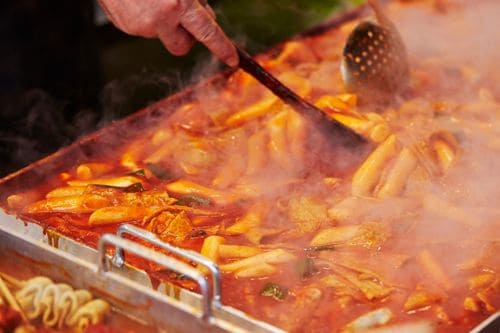
Imagine chewy, pillowy rice cakes bathed in a bold, fiery bath of chili pepper sauce, and you have tteokbokki. This Korean street food staple has been a beloved comfort food for centuries, tracing its roots back to the royal palace cuisine of the Joseon Dynasty.
When it comes to tteokbokki, variety is the spice of life. The cylindrical rice cakes are the base, but the sky’s the limit when it comes to added ingredients. Slippery fish cakes, runny boiled eggs, and crisp vegetables are all fair game.
Recipe
- Rinse the rice cakes in cold water to remove any excess starch, then drain and set aside.
In a small bowl, mix together the gochujang, sugar, soy sauce, corn syrup, minced garlic, and sesame oil. - In a large pan, heat some oil over medium heat. Add the sliced green onions, carrots, and onions and cook until they are soft and fragrant.
- Add the sauce mixture to the pan and stir to combine with the vegetables.
- Add the rice cakes to the pan and stir to coat them with the sauce. Cook for about 5-7 minutes, until the rice cakes have softened.
- If using, add the fish cakes and boiled eggs to the pan and stir to combine. Cook for another 2-3 minutes, until everything is heated through.
- Serve the tteokbokki in a bowl and garnish with sesame seeds and sliced green onions. Enjoy!
Best places to enjoy tteokbokki in Seoul
- Gwangjang Market
- Address: 88 Changgyeonggung-ro, Jongno-gu, Seoul
- Maboklim Wonjo Halmeonijip Ttokbokki
- Address: 5 Dasan-ro 35-gil, Sindang-dong, Jung-gu, Seoul
- Myeongdong Night Market
- Address: Chungmuro 2-ga, Jung-gu, Seoul
These are the must-try traditional Korean food while you are in Seoul, Korea. You can go to any of the recommended restaurants and can taste the dishes. If you like any of them you can easily prepare at home by following the instructions mentioned above.
IVK’s Top Picks – Day Tours, Tickets, and Travel Activities
Seasonal Picks!😍


